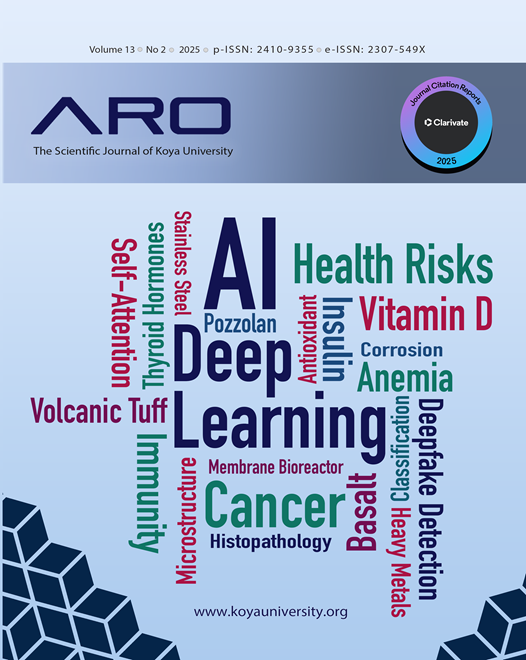A Hybrid Deep Learning Model with Self-Attention for the Classification of Lung Cancer Using Histopathology Image
DOI:
https://doi.org/10.14500/aro.12355Keywords:
Deep learning, Histopathology images, Lung cancer classification, Model evaluation, Primary lung cancerAbstract
Lung cancer remains a prevalent health burden and is one of the leading causes of cancer mortality worldwide. Its high mortality rate is partly attributable to histological heterogeneity and the difficulty of detecting it at early stages. An accurate distinction of lung cancer subtypes in histopathological images is crucial for improving the accuracy of diagnosis and planning an appropriate treatment to improve the quality of life of patients. This study proposes a hybrid deep-learning model for classifying cancer types using histopathology images. The ConvNeXt-Tiny is an extension of the ResNet-50 base architecture. This architecture is inspired by both models and introduces self-attention layers to improve both feature extraction and classification performance, leading to a unique model design. The proposed model and two other deep learning models were trained and tested using the public Lung and Colon Cancer Histopathological Image (LC25000) dataset and a private clinical dataset, and their effectiveness was evaluated. The proposed model outperformed the best classification accuracy among the other architectures (98.73% public and 93.17% private), outperforming baseline models, such as ConvNeXt-Tiny (96.27% public and 89.33% private) and ResNet-50 (94.00% public and 87.67% private). The results confirm the robustness and generalization ability of the proposed architecture.
Downloads
References
Ahmed, S., Shaikh, A., Alshahrani, H., Alghamdi, A., Alrizq, M., Baber, J., and Bakhtyar, M., 2021. Transfer learning approach for classification of histopathology whole slide images. Sensors, 21(16), p.5361. DOI: https://doi.org/10.3390/s21165361
Anjum, S., Ahmed, I., Asif, M., Aljuaid, H., Alturise, F., Ghadi, Y.Y., and Elhabob, R., 2023. Lung cancer classification in histopathology images using multiresolution efficient nets. Computational Intelligence and Neuroscience, 2023, pp.7282944. DOI: https://doi.org/10.1155/2023/7282944
Borkowski, A.A., Bui, M.M., Thomas, L.B., Wilson, C.P., DeLand, L.A., and Mastorides, S.M., 2019. Lung and Colon Cancer Histopathological Image Dataset (LC25000). [Preprint].
Devi, B.R., Sharma, A., Ramesh, S., and Kumar, R., 2024. Efficient NetB3 for enhanced lung cancer detection: Histopathological image study with augmentation. Journal of Information Technology Management, 16(1), pp.98-117.
El-Ghany, S.A., Azad, M., and Elmogy, M., 2023. Robustness fine-tuning deep learning model for cancers diagnosis based on histopathology image analysis. Diagnostics, 13(4), p.699. DOI: https://doi.org/10.3390/diagnostics13040699
Gong, W., Liu, X., Wang, Y., Zhang, H., and Zhao, J., 2025. Evaluation of an enhanced ResNet-18 classification model for rapid on-site diagnosis in respiratory cytology. BMC Cancer, 25(1), p.10. DOI: https://doi.org/10.1186/s12885-024-13402-3
Gowthamy, J., and Ramesh, S., 2024. A novel hybrid model for lung and colon cancer detection using pre-trained deep learning and KELM. Expert Systems with Applications, 252, p.124114. DOI: https://doi.org/10.1016/j.eswa.2024.124114
Hattori, H., Morikawa, T., Matsumoto, T., Shibata, H., Yamamoto, K., Takeda, Y., Nakamura, S., Fujita, T., and Nakano, T., 2023. Tumor-identification method for predicting recurrence of early-stage lung adenocarcinoma using digital pathology images by machine learning. Journal of Pathology Informatics, 14, p.100175. DOI: https://doi.org/10.1016/j.jpi.2022.100175
Hatuwal, B.K., and Thapa, H.C., 2020. Lung cancer detection using convolutional neural network on histopathological images. International Journal of Computer Trends and Technology, 68(10), pp.21-24. DOI: https://doi.org/10.14445/22312803/IJCTT-V68I10P104
Howlader, N., Noone, A.M., Krapcho, M., Miller, D., Brest, A., Yu, M., Ruhl, J., Tatalovich, Z., Mariotto, A., Lewis, D.R., Chen, H.S., Feuer, E.J., and Cronin, K.A., 2020. The effect of advances in lung-cancer treatment on population mortality. New England Journal of Medicine, 383(7), pp.640-649. DOI: https://doi.org/10.1056/NEJMoa1916623
Hua, W., Li, C., and Wang, X., 2024. Review of convolutional neural network models and image classification. Academic Journal of Science and Technology, 10(3), pp.178-184. DOI: https://doi.org/10.54097/644jqv20
Ijaz, M., Qureshi, S.A., Khan, M.A., Ashraf, I., Zahid, U., Yasin, A., Zhang, Y.D., and Wang, S., 2023. DS²LC³Net: A decision support system for lung colon cancer classification using fusion of deep neural networks and normal distribution based gray wolf optimization. ACM Transactions on Asian and Low-Resource Language Information Processing. New York: ACM Publications, p.3625096. DOI: https://doi.org/10.1145/3625096
Kanavos, A., and Mylonas, P., 2023. Deep learning analysis of Histopathology images for breast cancer Detection: A Comparative Study of ResNet and VGG Architectures. In: 2023 18th International Workshop on Semantic and Social Media Adaptation and Personalization (SMAP). IEEE, pp.1-6. DOI: https://doi.org/10.1109/SMAP59435.2023.10255168
Khan, S., Naseer, M., Hayat, M., Zamir, S.W., Khan, F.S., and Shah, M., 2022. Transformers in vision: A survey. ACM Computing Surveys, 54(10), p.200. DOI: https://doi.org/10.1145/3505244
Komura, D., and Ishikawa, S., 2018. Machine learning methods for histopathological image analysis. Computational and Structural Biotechnology Journal, 16, pp.34-42. DOI: https://doi.org/10.1016/j.csbj.2018.01.001
Kriegsmann, M., Haag, C., Weis, C.A., Steinbuss, G., Warth, A., Zgorzelski, C., Muley, T., Winter, H., Eichhorn, M.E., Eichhorn, F., Kriegsmann, J., Christopolous, P., Thomas, M., Witzens-Harig, M., Sinn, P., Von Winterfeld, M., Heussel, C.P., Herth, F.J.F., Klauschen, F., Stenzinger, A., and Kriegsmann, K., 2020. Deep learning for the classification of small-cell and non-small-cell lung cancer. Cancers, 12(6), p.1604. DOI: https://doi.org/10.3390/cancers12061604
Kumar, N., Sharma, M., Singh, V.P., Madan, C., and Mehandia, S., 2022. An empirical study of handcrafted and dense feature extraction techniques for lung and colon cancer classification from histopathological images. Biomedical Signal Processing and Control, 75, p.103596. DOI: https://doi.org/10.1016/j.bspc.2022.103596
Liu, Z., Mao, H., Wu, C.Y., Feichtenhofer, C., Darrell, T., and Xie, S., 2022. A ConvNet for the 2020s. In: Proceedings of the 2022 IEEE/CVF Conference on Computer Vision and Pattern Recognition (CVPR). IEEE, pp.11966-11976. DOI: https://doi.org/10.1109/CVPR52688.2022.01167
Masud, M., Sikder, N., Abdullah-Al Nahid, A., Bairagi, A.K., and AlZain, M.A., 2021. A machine learning approach to diagnosing lung and colon cancer using a deep learning-based classification framework. Sensors (Basel, Switzerland), 21(3), p.748. DOI: https://doi.org/10.3390/s21030748
Mehmood, S., Ghazal, T.M., Khan, M.A., Zubair, M., Naseem, M.T., Faiz, T., and Ahmad, M., 2022. Malignancy detection in lung and colon histopathology images using transfer learning with class selective image processing. IEEE Access, 10, pp.25657-25668. DOI: https://doi.org/10.1109/ACCESS.2022.3150924
Nicholson, A.G., Tsao, M.S., Beasley, M.B., Borczuk, A.C., Brambilla, E., Cooper, W.A., Dacic, S., Jain, D., Kerr, K.M., Lantuejoul, S., Noguchi, M., Papotti, M., Rekhtman, N., Scagliotti, G., Van Schil, P., Sholl, L., Yatabe, Y., Yoshida, A., and Travis, W.D., 2022. The 2021 WHO classification of lung tumors: Impact of advances since 2015. Journal of Thoracic Oncology, 17(3), pp.362-387. DOI: https://doi.org/10.1016/j.jtho.2021.11.003
Rajasekar, V., Vaishnnave, M.P., Premkumar, S., Sarveshwaran, V., and Rangaraaj, V., 2023. Lung cancer disease prediction with CT scan and histopathological images feature analysis using deep learning techniques. Results in Engineering, 18, p.101111. DOI: https://doi.org/10.1016/j.rineng.2023.101111
Raschka, S., Mirjalili, V., and Raschka, J., 2022. Machine Learning with PyTorch and Scikit-Learn: Develop Machine Learning and Deep Learning Models with Scikit-Learn and PyTorch. Packt Publishing, Birmingham. Siegel, R.L., Giaquinto, A.N., and Jemal, A., 2024. Cancer statistics, 2024. CA: A Cancer Journal for Clinicians, 74(1), pp.12-49.
Sumon, R.I., Mazumdar, M.A.I., Uddin, S.M.I., and Kim, H.C., 2024. Exploring Deep Learning and Machine Learning Techniques for Histopathological Image Classification in Lung Cancer Diagnosis. In: 2024 International Conference on Electrical, Computer, and Energy Technologies (ICECET). IEEE, pp.1-6. Tortora, M., Cordelli, E., Sicilia, R., Nibid, L., Ippolito, E., Perrone, G., Ramella, S., and Soda, P., 2023. DOI: https://doi.org/10.1109/ICECET61485.2024.10698211
RadioPathomics: Multimodal learning in non-small cell lung cancer for adaptive radiotherapy. IEEE Access, 11, pp.47563-47578. DOI: https://doi.org/10.1109/ACCESS.2023.3275126
Tummala, S., Yedla, R.N., Ahmed, K., Katukojwala, A., Vankayalapati, S.L.V., and Garikapati, V., 2023. An explainable classification method based on complex scaling in histopathology images for lung and colon cancer. Diagnostics, 13(9), p.1594. DOI: https://doi.org/10.3390/diagnostics13091594
Wei, J.W., Tafe, L.J., Linnik, Y.A., Vaickus, L.J., Tomita, N., and Hassanpour, S., 2019. Pathologist-level classification of histologic patterns on resected lung adenocarcinoma slides with deep neural networks. Scientific Reports, 9, p.3358. DOI: https://doi.org/10.1038/s41598-019-40041-7
Yang, H., Chen, L., Cheng, Z., Yang, M., Wang, J., Lin, C., Wang, Y., Huang, L., Chen, Y., Peng, S., Ke, Z., and Li, W., 2021. Deep learning-based six-type classifier for lung cancer and mimics from histopathological whole slide images: A retrospective study. BMC Medicine, 19, p.80. DOI: https://doi.org/10.1186/s12916-021-01953-2
Downloads
Published
How to Cite
Issue
Section
License
Copyright (c) 2025 Lana L. Nahmatwlla, Abbas M. Ali

This work is licensed under a Creative Commons Attribution-NonCommercial-ShareAlike 4.0 International License.
Authors who choose to publish their work with Aro agree to the following terms:
-
Authors retain the copyright to their work and grant the journal the right of first publication. The work is simultaneously licensed under a Creative Commons Attribution License [CC BY-NC-SA 4.0]. This license allows others to share the work with an acknowledgement of the work's authorship and initial publication in this journal.
-
Authors have the freedom to enter into separate agreements for the non-exclusive distribution of the journal's published version of the work. This includes options such as posting it to an institutional repository or publishing it in a book, as long as proper acknowledgement is given to its initial publication in this journal.
-
Authors are encouraged to share and post their work online, including in institutional repositories or on their personal websites, both prior to and during the submission process. This practice can lead to productive exchanges and increase the visibility and citation of the published work.
By agreeing to these terms, authors acknowledge the importance of open access and the benefits it brings to the scholarly community.
Accepted 2025-08-21
Published 2025-09-01
















 ARO Journal is a scientific, peer-reviewed, periodical, and diamond OAJ that has no APC or ASC.
ARO Journal is a scientific, peer-reviewed, periodical, and diamond OAJ that has no APC or ASC.